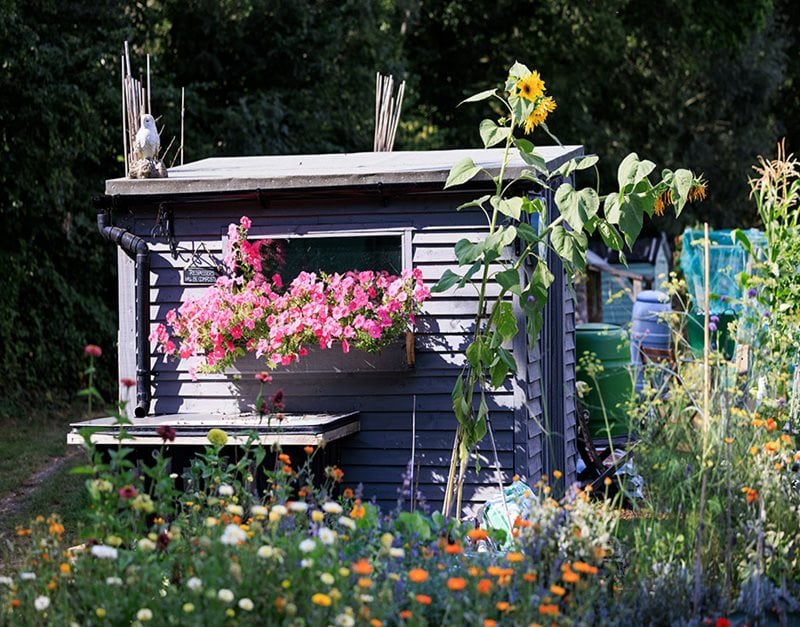Tips to help you get the most out of your allotment and enjoy a healthy, good-looking plot
An inherited plot
It is unusual to take over a pristine plot, many are in very bad shape, covered in weeds, debris and rubbish. The first step is looking at the plot as a whole and identifying what will give you the most pleasure and productivity.

Pretty and practical
If looks come first, a plot may be laborious and output may suffer. Low, clipped hedges, for example, are troublesome, and narrow paved paths are awkward, inflexible and need a lot of weeding.
Attractive additions
Here are some creative ideas to help make your allotment extra special:
-
Create practical but pretty home-made supports for beans and climbing flowers
-
Pimp up your shed, giving it a new coat of paint and add a seasonal wreath of treasures from the plot. Make use of its height by adding climbing crops and flowers
-
Create raised beds with defined edges, which make it much easier to keep the plot looking neat as well as accessible
-
Compost bins are not things of beauty, but can be positioned in the least-valued part of your plot and disguised with ornamental plants
- Ponds, wildflower areas and other ornamental features can be added to increase biodiversity without overly compromising the productivity of your allotment.

Practical constraints
If changes in family, health, or work circumstances affect your time, it might be wise to downsize to a smaller plot for a while. Perhaps leave the plot for a year, covering the soil with a thick mulch or a weed-suppressing membrane. Conditions often stipulate that at least two-thirds of a plot must be under cultivation, so you need to agree this in advance.
Water wisely
Dip tanks filled from the mains are the most common watering arrangement on allotments. Sprinklers, standpipes and hoses are rare, and push the cost of rent up. A lot of water used on plots is wasted. Water plants thoroughly in rotation, rather than distributing water widely and thinly. The cost of water is included in the rent and you are expected to use it responsibly.
Assess your plot
Allotment plots may look like blank canvasses of earth, but no two are quite alike. Take stock of what you have on your site and decide what you need to keep, change or remove. Agree any activities with the site management first.
- Tree boughs can be pruned (with permission) for stakes, and their leaves composted
- Terracing can be used on slopes to make easy-to-work raised beds
- Wet patches are problematic, but are perfect if you want to install a pond
- Most sites have areas of neglect, such as banks, hedges and ditches, that offer potential sources of pea sticks, leaves for leafmould and vegetation for compost
Paths and boundaries
Good access to all areas, with paths to tend and gather your crops, is crucial. Paths within the plot use vital cropping space and are best avoided, but are essential for working on beds.
Permanent paths between raised beds can be kept weed-free with a suitable membrane or with recycled, chipped wood. Council, tree contractors often supply allotment sites with chipped timber for this. Temporary paths can be left as bare soil.
Maintaining the edges and boundaries are crucial to a well-kept and easy to maintain plot. Wooden edging boards reduce the labour of trimming, often at the busiest time of the growing season. Here are some suggestions on how to keep weeds under control.

Plan your crop rotation
By never growing crops in the same place twice in a row, you avoid soil-borne pests and diseases. For the crops a typical plot-holder grows, a four-course rotation is best. Each bed should grow, in order:
- Year 1: potatoes and tomatoes
- Year 2: root vegetables (including onions)
- Year 3: peas and broad beans
- Year 4: brassicas
Pumpkins, squash, courgettes, French and runner beans, sweetcorn and sweet potatoes have few pests or diseases and can be slotted in where convenient.
Mix up your crops
According to the theory of companion planting, mixing plants together confuses insects, especially if you mix a strongly scented plant such as French marigolds with vulnerable crops such as runner beans.
Successionally sow and intercrop
To ‘intercrop’, you sow and harvest a quick crop between a widely spaced, slow-growing crop. Widely spaced Brussels sprouts, for example, allow you to sow lettuce in early spring and crop before the sprouts, which are planted in late spring, grow too large. With skill (and good weather) you can fit in a quick-growing crop before or after the main crop is finished: early peas allow for a quick crop of autumn turnips, for example.
Successional sowing at intervals spreads a crop out: you might sow peas in early spring and then again each time the last sowing is 5cm (2in) high so they mature in turn without gluts.
Crop protection
Protection from the weather will boost growth and exclude pests. Fleece is cheap and gives a two-week ‘advance’ in spring-sown crops by providing extra warmth and shelter from wind; plastic cloches do slightly better. Both are vulnerable to wind and other damage, and often need netting over them.
Old windows are sometimes used to make traditional allotment cold frames, but are also easily broken. Proprietary frames are expensive and you might think twice before leaving them on the plot, but a well-made frame can advance crops by up to a month, so it’s worth exercising your creative skills or saving up for one.
For fruit protection, fruit cages are an expensive but effective way of covering a crop and keeping birds from your precious berries. You can also create these yourself using canes and netting, but be careful with cane ends, adding a topper to prevent injuries.

You may also like to read

